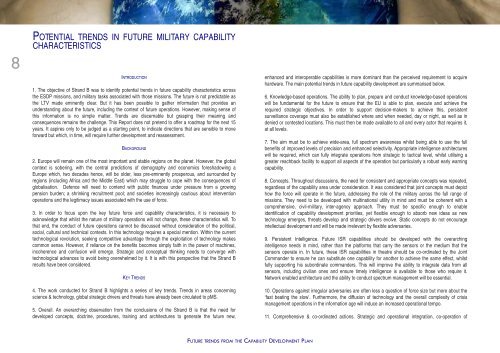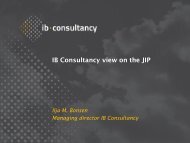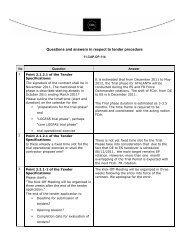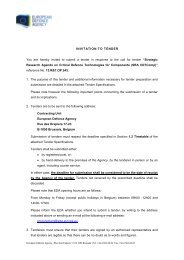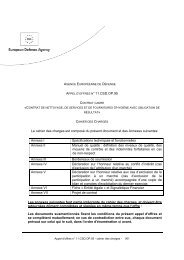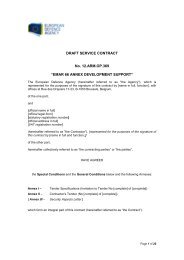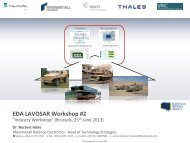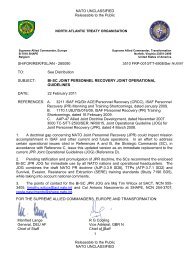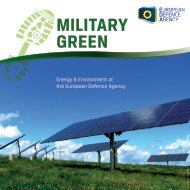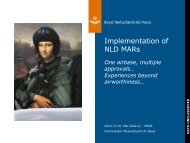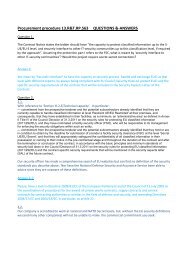capability development plan - European Defence Agency - Europa
capability development plan - European Defence Agency - Europa
capability development plan - European Defence Agency - Europa
You also want an ePaper? Increase the reach of your titles
YUMPU automatically turns print PDFs into web optimized ePapers that Google loves.
8<br />
POTENTIAL TRENDS IN FUTURE MILITARY CAPABILITY<br />
CHARACTERISTICS<br />
INTRODUCTION<br />
1. The objective of Strand B was to identify potential trends in future <strong>capability</strong> characteristics across<br />
the ESDP missions, and military tasks associated with those missions. The future is not predictable as<br />
the LTV made eminently clear. But it has been possible to gather information that provides an<br />
understanding about the future, including the context of future operations. However, making sense of<br />
this information is no simple matter. Trends are discernable but grasping their meaning and<br />
consequences remains the challenge. This Report does not pretend to offer a roadmap for the next 15<br />
years. It aspires only to be judged as a starting point, to indicate directions that are sensible to move<br />
forward but which, in time, will require further <strong>development</strong> and reassessment.<br />
BACKGROUND<br />
2. Europe will remain one of the most important and stable regions on the <strong>plan</strong>et. However, the global<br />
context is sobering, with the central predictions of demography and economics foreshadowing a<br />
Europe which, two decades hence, will be older, less pre-eminently prosperous, and surrounded by<br />
regions (including Africa and the Middle East) which may struggle to cope with the consequences of<br />
globalisation. <strong>Defence</strong> will need to contend with public finances under pressure from a growing<br />
pension burden; a shrinking recruitment pool; and societies increasingly cautious about intervention<br />
operations and the legitimacy issues associated with the use of force.<br />
3. In order to focus upon the key future force and <strong>capability</strong> characteristics, it is necessary to<br />
acknowledge that whilst the nature of military operations will not change, these characteristics will. To<br />
that end, the conduct of future operations cannot be discussed without consideration of the political,<br />
social, cultural and technical contexts. In this technology requires a special mention. Within the current<br />
technological revolution, seeking competitive advantage through the exploitation of technology makes<br />
common sense. However, if reliance on the benefits becomes simply faith in the power of machines,<br />
incoherence and confusion will emerge. Strategic and conceptual thinking needs to converge with<br />
technological advances to avoid being overwhelmed by it. It is with this perspective that the Strand B<br />
results have been considered.<br />
KEY TRENDS<br />
4. The work conducted for Strand B highlights a series of key trends. Trends in areas concerning<br />
science & technology, global strategic drivers and threats have already been circulated to pMS.<br />
5. Overall. An overarching observation from the conclusions of the Strand B is that the need for<br />
developed concepts, doctrine, procedures, training and architectures to generate the future new,<br />
enhanced and interoperable capabilities is more dominant than the perceived requirement to acquire<br />
hardware. The main potential trends in future <strong>capability</strong> <strong>development</strong> are summarised below.<br />
6. Knowledge-based operations. The ability to <strong>plan</strong>, prepare and conduct knowledge-based operations<br />
will be fundamental for the future to ensure that the EU is able to <strong>plan</strong>, execute and achieve the<br />
required strategic objectives. In order to support decision-makers to achieve this, persistent<br />
surveillance coverage must also be established where and when needed, day or night, as well as in<br />
denied or contested locations. This must then be made available to all and every actor that requires it,<br />
at all levels.<br />
7. The aim must be to achieve wide-area, full spectrum awareness whilst being able to use the full<br />
benefits of improved levels of precision and enhanced selectivity. Appropriate intelligence architectures<br />
will be required, which can fully integrate operations from strategic to tactical level, whilst utilising a<br />
greater reachback facility to support all aspects of the operation but particularly a robust early warning<br />
<strong>capability</strong>.<br />
8. Concepts. Throughout discussions, the need for consistent and appropriate concepts was repeated,<br />
regardless of the <strong>capability</strong> area under consideration. It was considered that joint concepts must depict<br />
how the force will operate in the future, addressing the role of the military across the full range of<br />
missions. They need to be developed with multinational utility in mind and must be coherent with a<br />
comprehensive, civil-military, inter-agency approach. They must be specific enough to enable<br />
identification of <strong>capability</strong> <strong>development</strong> priorities, yet flexible enough to absorb new ideas as new<br />
technology emerges, threats develop and strategic drivers evolve. Static concepts do not encourage<br />
intellectual <strong>development</strong> and will be made irrelevant by flexible adversaries.<br />
9. Persistent Intelligence. Future ISR capabilities should be developed with the overarching<br />
intelligence needs in mind, rather than the platforms that carry the sensors or the medium that the<br />
sensors operate in. In future, these ISR capabilities in theatre should be co-ordinated by the Joint<br />
Commander to ensure he can substitute one <strong>capability</strong> for another to achieve the same effect, whilst<br />
fully supporting his subordinate commanders. This will improve the ability to integrate data from all<br />
sensors, including civilian ones and ensure timely intelligence is available to those who require it.<br />
Network enabled architecture and the ability to conduct spectrum management will be essential.<br />
10. Operations against irregular adversaries are often less a question of force size but more about the<br />
‘fast beating the slow’. Furthermore, the diffusion of technology and the overall complexity of crisis<br />
management operations in the information age will induce an increased operational tempo.<br />
11. Comprehensive & co-ordinated actions. Strategic and operational integration, co-operation of<br />
FUTURE TRENDS FROM THE CAPABILITY DEVELOPMENT PLAN


